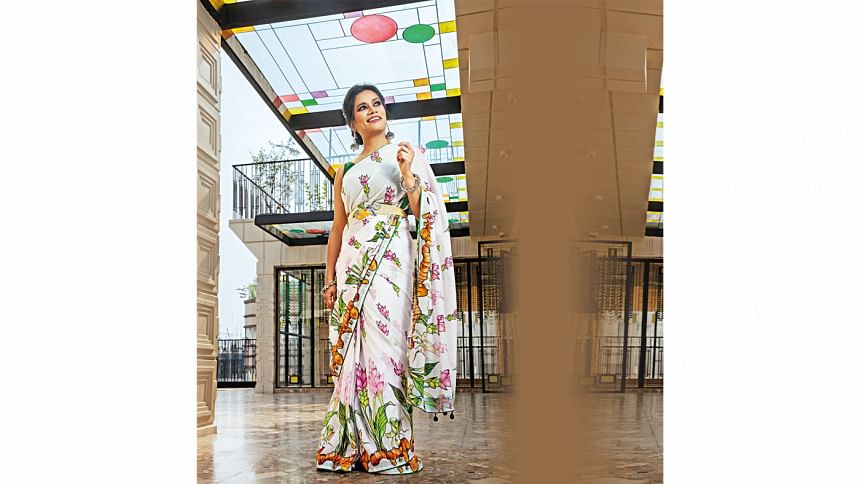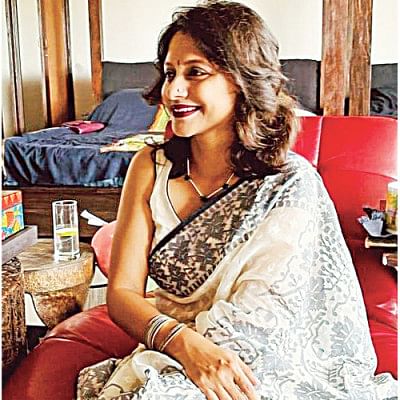Embracing the slow fashion movement: In conversation with Silmat Chisti


Slow fashion, as the definition roughly entails, is couture that is hand-spun and has its roots steeped in tradition, and is focused on sustainable and ethical productions. The Daily Star recently spoke to Silmat Chisti, Founder, NOBO Designs Pvt Ltd, also MD, Bangladesh SME Corporation Ltd. She shed some light on the Slow Fashion movement in Bangladesh.
The word slow fashion gets tossed around a lot these days. Yet, the definition is perhaps still not clear. So, first things first; what is slow fashion?
There are many definitions of 'slow fashion,' and in many places, it may be a legally defined term, but to us, what it essentially means is a fashion movement that is mindful of life around us.
Clothing oneself is a fundamental human need and there are a million ways of doing so. Socially conscious consumers are now embracing slow fashion as a means of clothing themselves.
Slow fashion is a conscious movement to integrate life around us in both the production and consumption of fashion items and thinking through the consequences of every step. It is opposite to what is known as 'fast fashion.'
Ideas that are integral to slow fashion include the use of ethically sourced natural yarn, preservation of heritage hand craftsmanship, minimising use of fossil fuel, fair pay and fair credit for artisans, eco-friendly production chain, sustainable ethical processes, etc.
Ethical practice is at the core of a vibrant slow fashion industry. You cannot pass off machine-made products as slow fashion. The role of government and trade/craft bodies is huge in vitalising slow fashion.
Training, exhibitions, economic incentives, monitoring, etc. are very much needed. The most important role of technology in slow fashion is that e-commerce platforms have created the ability to match buyers and sellers directly, cutting a lot of middlemen expenses. It also brings price clarity/efficiency along the value chain. It enables better documentation of a body of work by any craftsman over a lifetime.
So, is slow fashion part of haute couture?
Haute Couture is a highly defined term and is almost always used improperly. There are very strict guidelines as to what qualifies as 'haute couture' in Paris and only a handful of fashion houses globally qualify for the label.
If by haute couture you mean high fashion, then, no, all slow fashion is not high fashion.
High fashion also is a term that reflects production steps from end to finish, starting with the use of expensive textiles to the tailored final output and all else in between. Bangladesh does not have any meaningful presence in high fashion, yet.
There is a common perception that deshi wear automatically be termed as slow fashion. To what extent is that true? Do all deshi fashion wear fall into the slow fashion category?
All deshi fashion do not fall under the slow fashion category, but many of our heritage crafts do by nature of several factors, such as the use of human hands for craftsmanship, the use of centuries-old craft techniques that are eco-friendly, the use of local natural materials, recycling, etc.
How is fair trade involved in the production of slow fashion by local producers?
Fair trade is a very complicated matter. As a base, it assumes that all players in the value chain are adhering to a set of ethical practices and being compensated properly. All this is of course reflected in higher prices and slower production.
While in theory, this Utopian practice is wonderful, there are many practical hurdles in execution and for countries like Bangladesh, it may even translate to becoming non-competitive. Hence, there is always a balancing game that needs to happen. I believe in "as fairly as possible."
How do you attract the general mass to slow fashion or is slow fashion only affordable to the rich?
Slow fashion will always be more expensive than fast fashion. There is no way around it. However, we can pay heed to our consumption patterns. Instead of buying 12 new things a year, we can reduce consumption to say, 6 things a year, of which 3 are "slow fashion" items.
I believe in buying "meaningfully," buying as much local as possible but also in supporting craftsmen around the world.
A country like Bangladesh that makes its money from fast fashion should not knock fast fashion. Let us also be mindful that fast fashion, i.e., industrialisation, has enabled the majority of our population to be clothed. What we should instead focus on are reducing fast fashion pollution, equitable work conditions/pay for those employed in the sector, recycling industrial waste, and other such practical strategies.
Is it possible to wear deshi fashion products and always look trendy?
Absolutely! Bangladesh is a candy store for fashion choices. With our rich heritage in local textile options and our role as "tailors to the world," there is nothing we cannot do in Bangladesh. What we can and should spend more time developing as a nation are world-class fashion designers who can use these materials and go the last mile of putting the final look together.
We still do not have meaningful world-class fashion brands in Bangladesh. While that is happening, we can continue to be our own stylists. I think it is very important to dress one's identity and not just buy "designer" to signal one's financial ability.
Additionally, it is very important to educate ourselves on local heritage crafts and craftsmanship and appreciate that it will not match fast fashion prices. For instance, very few of us understand or appreciate that Jamdani is the most difficult weave in the world and as such, will be priced higher than anything else. Or synthetic passed as silk will be cheaper than the real fabric.
As for styling ourselves, as step one, we would start by imagining what we would want in our ideal wardrobe. It should include a set of regular wear and a list of "collectibles.". Step two would be to make a list of local businesses that source and produce locally. Step three would be the fun part. Mix and match and see what works. And the collectibles can be a lifelong project, matching milestones in life. Clothes don't make a person, and vice versa.
How do we bring diversity to slow fashion so that it becomes trendy for young people?
There has to be a bit of give and take and a lot of education at both buyer and seller ends. Slow fashion has to stop being "boring" and stereotypical and invest in design and cuts as a priority and young people have to switch from craving "something new and cheap, daily" to buying "mindfully." It is an ongoing social process and we have to keep education at the forefront of both parties.
The slow fashion players have been more focused on capturing the export market, but I believe that the timing is right to focus on domestic consumption. As the country graduates into a middle-income economy, the local market seems ready for mindful fashion.
By Star Lifestyle Desk
Photo: Shahrear Kabir Heemel
Model: Shanila Mehjabin
Wardrobe: NOBO Dhaka
Collection: Bangladeshi Heshel, both hand-painted and digitally printed 100 count Egyptian cotton kota
Makeup: Shababa Rashid
Hair: Mia Bella Salon
Styling: Saki Kazi and Shezami Khalil

 For all latest news, follow The Daily Star's Google News channel.
For all latest news, follow The Daily Star's Google News channel. 



Comments